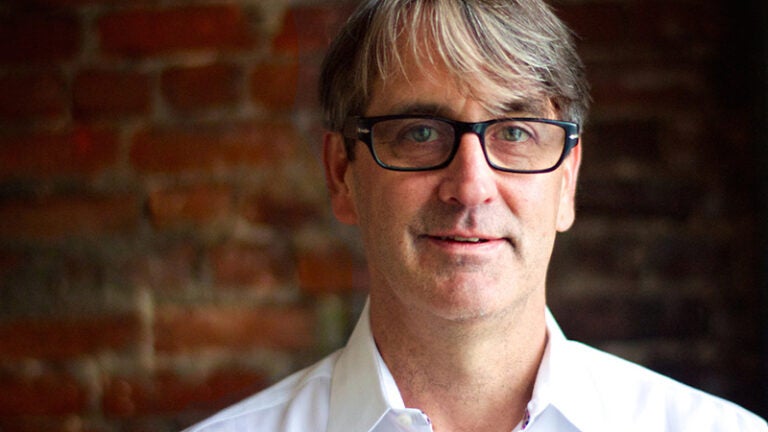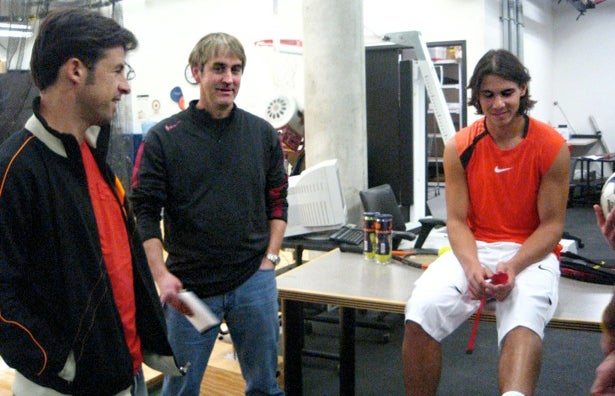
High Performance
Throughout his 30-year career with Nike, USC Dornsife alumnus Michael Bergmann recalled how again and again he would be thrown into a situation where he had to think on his feet to solve a problem.
In one scenario in 2004, a product development team brought him in to update its tennis shoes for high-performance players such as Andre Agassi, Roger Federer and Serena Williams. On the courts, the tennis pros’ shoes would take a beating and the soles would quickly wear through.
“When you play tennis, your shoes are basically rubber going across sandpaper at high temperatures,” explained Bergmann, who earned his bachelor’s in international relations in 1983.
In particular, Bergmann studied the shoes of tennis pro Rafael Nadal. Nadal, who grew up in Spain, honed his skills on clay courts, gliding from side to side on the court by using one of his feet as a rudder to keep steady. Oftentimes, he had to change his shoes multiple times in a match, especially when he played on hard court surfaces in the United States or Australia.
“He was burning through the bottoms and tops of his shoes,” Bergmann said. So with a critical eye, Bergmann began to reverse engineer the problem. He concluded that the soles of Nike’s tennis shoes needed to be as sturdy as the rubber on Formula One race cars, which could withstand turning tight corners at top speeds.
Working with a chemist and an engineer, Bergmann developed and jointly holds the patent on the exceedingly durable rubber compound XDR, which is still used in Nike shoes today.

Michael Bergmann (center) and his team evaluate footwear performance needs for tennis pro Rafael Nadal (right) at the Nike Sports Research Lab in Beaverton, Oregon, in 2004.
“Not only did our products last longer than other products, but it became the most durable compound in the industry,” Bergmann said. “Our outdoor basketball shoes also adopted it.”
Bergmann credits his ingenuity to his time at USC Dornsife.
“I always wanted to put myself in a situation where I could learn something new,” Bergmann said. “A lot of that was the mentality I took from my time as an undergraduate studying liberal arts. I learned critical thinking where you have to be able to put yourself in a situation and use those skills to come up with solutions.”
Bergmann, who started working for Nike selling shoes in a retail store while in high school, used his time in the USC Dornsife School of International Relations to learn how to excel at the company.
“My time at USC Dornsife was phenomenal,” Bergmann said. “Professors Steven Lamy and Gerald Bender were really inspirational. My focus in international relations allowed me to look at all sides of an issue, whether it was from a company standpoint, a government standpoint or a cultural standpoint.”
For one assignment, Bergmann wrote a paper about multinational corporations and world politics. Bergmann, who continued working for Nike throughout college, reached out to the company’s top executives in conducting some of the research.
“I continued to pursue those connections post-college and that parlayed itself into a long, successful career for me at Nike,” Bergmann said.
Following his senior year, Bergmann participated in one of USC’s early overseas programs in China where he spent the summer learning Chinese.
A few years later, his language experience was recognized by Nike, which was venturing into the Chinese market. The company asked him to move to China to oversee factories as a footwear production manager at age 26. Following three years in China, Bergmann spent another three years in Jakarta, Indonesia, as a production manager and then in product development before returning to Nike headquarters in Beaverton, Oregon.
“I worked in almost every area of Nike in Footwear Product Creation with the exception of the running category,” Bergmann said.

A competitive runner middle school through college, Michael Bergmann (right) directs the track and field program at Central Catholic High School in Portland, Oregon.
Bergmann is himself a track and field athlete, and wanted to push himself in unfamiliar areas. He ran competitively in middle school through his early college years — as a high school senior he was among the top 20 1500-meter runners in the country. Now, in addition to working on two new business ventures, he directs the track and field program at Central Catholic High School in Portland, Oregon, where he lives.
Bergmann recently returned to USC Dornsife to share his insights with students, taking them through his career with Nike and introducing them to two new businesses he is working on. The presentation was hosted by Steven Lamy, professor of international relations and vice dean for academic programs.
One business, Red Truck, of which Bergmann is CEO, is an online marketplace where sports enthusiasts can buy and sell high-end gear. The other is Bergmann’s brainchild, IncubatorU.
IncubatorU is a recently launched mobile innovation lab. The company creates an environment where someone can bring a project or product to fruition with the input and support of experts from various backgrounds — business, engineering, marketing or any area pertinent to their concept.
“We bring intersectional thinking to a project, map out what the resources are, and then put together a plan with small executable steps, so we’re prototyping things without a huge amount of capital investment,” Bergmann explained.
Bergmann hopes to launch a version of IncubatorU at USC where students can make use of the multi-disciplinary expertise of faculty and staff across campus.
“Between USC Dornsife and the other colleges, like the USC Marshall School of Business, the USC Viterbi School of Engineering, the USC School of Cinema and the USC Annenberg School for Communication and Journalism,” Bergmann said, “there is great potential to launch ideas and companies from an interdisciplinary team.”